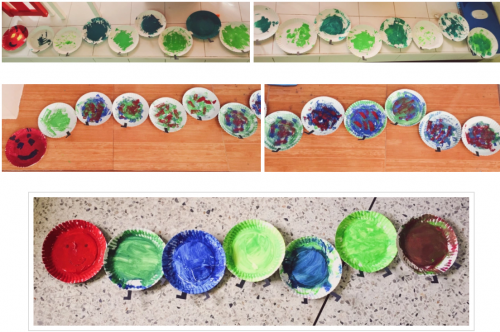
The curtains above the bed in my old room say “God is An Artist’’, over and over again. But what does that really mean and how do we reconcile that image with what we see as we come together in a Christian community that includes both disabled and non-disabled people? Is our first thought, when looking at the children of Rainbow House, to think that God maybe missed a stroke or two? That he overlooked some children or didn’t love them as much? Or even if you are non-Christian, do you believe that those who are disabled are less of a human than those who aren’t? I believe that my thoughts echo the rest of the CCD community when I argue a firm no – that in fact, every child here is beautifully made. This is not just me and my runaway thoughts, but this is gathered from what the workers here have said to me, and most importantly, what the children have shown me. They show me that they too are made in the image of God, and that they too are artists.
Since coming here, my volunteer coordinator (Biz) and I have created and executed a project involving weekly crafts done at three sites across CCD – effectively standardizing the sites and allowing for measurement and comparison. The crafts are designed as a kind of art therapy to give the children an outlet for their emotions and to help the children with their cognitive development (following instructions, sensory stimulation, colors and shapes) and physical development (hand-eye coordination, hand dexterity, other motor skills, etc). The images following show these four crafts done by children at three sites: two sites house disabled children (ages 2-10 and ages 10+) and one site houses normally developing children (ages 2-7). Try and guess which image came from which site.
The first craft focused on colors and shapes by having the children decorate butterflies using stickers and stamps. Here was the example shown:

Here is what the children came up with:

The second craft was a collaborative effort, with each kid making a piece of a large caterpillar:

The third craft involved use of fine motor skills, in which the children were instructed to decorate fruits by crumpling up tissue paper*:

*due to rain this craft was not performed at the third site
Finally, the fourth craft encouraged hand-eye coordination by having the children thread a “shoelace” through their “shoes”:

………………………………………………………………………………………………………………………………………………
The images in each row are, from left to right (or top to bottom in the case of craft 2): Rainbow House (disabled children ages 2-10), New Hope (normally developing children ages 2-7), and Rachawadee Girls (disabled children ages 10+). Did you guess right? Of course, this is not meant to be any kind of research study, and I think that everyone who reads this will come to their own conclusion. I wanted this mini project to not only highlight the work that Biz and I have done so far, but also to frame my intent behind the larger narratives project. As I begin the process of forming my narratives, my purpose in mind is this: to let the children show themselves free of the bias and stereotypes that cloud our judgment, for both them and the world to see. It’s known that art is a powerful medium for expression to others, for creating meaning out of our thoughts and feelings, and for insight into oneself. Isn’t it fitting then, to use these children’s art to mark the beginning of my narratives project?
Art is the window to man’s soul. Without it, he would never be able to see beyond his immediate world; nor could the world see the man within. – Claudia Lady Bird Johnson
Perhaps while reading this, you found some insight into children with disability. Or perhaps you thought that this was complete nonsense. Hopefully though, this was a preview that got you a little bit more excited to uncover some stories. If that’s the case, be on the lookout for my first narrative on Daa, one of the boys who moved here from our community rehabilitation project in Chai Nat, coming soon!
